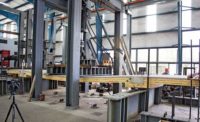That is not easy to do. The regulatory community still "ignores the existence of engineering methods that can provide solutions for timber buildings," says Jose L. Torero, head of the school of civil engineering at the University of Queensland, Australia, and one of SOM's reviewers, adding, "Timber is just more engineering-intensive, but it can lead to a more sustainable building."
For its study prototype, SOM used an existing concrete-structural-tube frame as a benchmark. The team selected the 42-story DeWitt Chestnut Apartments in Chicago, designed by SOM in the mid-1960s, because it is simple and rectilinear.
SOM even developed a typical interior floor plan for the building to demonstrate marketability. The team says the prototype is feasible from the standpoint of engineering, architecture, interior layouts and building services.
The study also took into account constructibility, cost, fire protection and sustainability. By SOM's calculations, the prototype's carbon footprint is 60% to 75% less than the benchmark's.
The structure consists of solid-mass timber products connected with reinforcing steel through concrete joints. Columns are made of glue-laminated timber. Walls and floors are made of cross-laminated timber, which consists of layers of wood at 90° angles to each other.
Rebar is connected to primary structural elements by epoxy-bonding reinforcement set in drilled holes in the timber. Members are connected to each other by lap-splicing rebar through the concrete joints. The result is concrete bands at the perimeter and at all wall-floor intersections. The concrete allows for conventional connections of the curtain wall and other systems. Steel plates anchor timber columns against uplift at lower levels. The foundations are concrete.
Wood absorbs moisture. Therefore, a timber frame requires greater attention from the designer, contractor and end user to keep it as durable as other materials, says Johnson. Exterior walls must be detailed to keep out moisture. Interfaces of the concrete and timber elements also must be detailed to ensure the timber does not absorb moisture from the concrete.
The system has no height limit. But concrete columns at the base are advisable for towers taller than 60 stories because timber columns would be too massive.
Though seismic considerations were not part of the study, there is no reason the system could not be adapted for seismic locations, says Johnson.
Timber-building enthusiast Michael Green, a Vancouver, B.C.-based architect who has written extensively on tall timber structures, welcomes the SOM research, calling it "exciting and positive" for mass- timber frames. He adds, "The U.S. has been quite a bit behind [in this], and it is great SOM is coming into the game."






Post a comment to this article
Report Abusive Comment